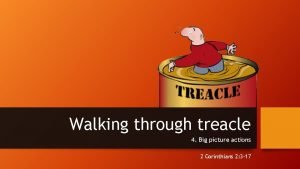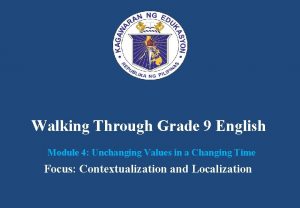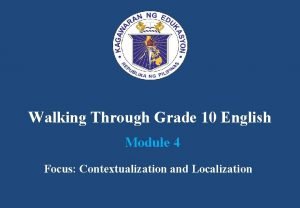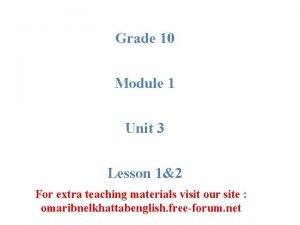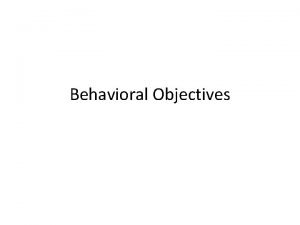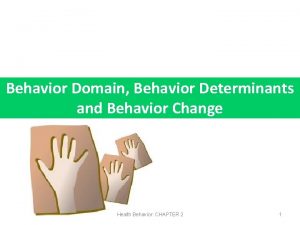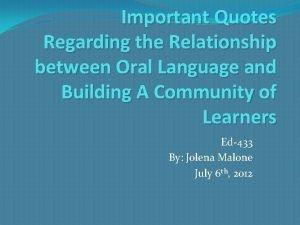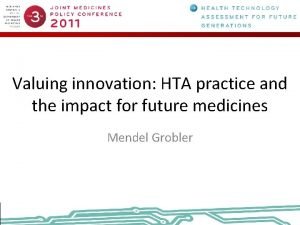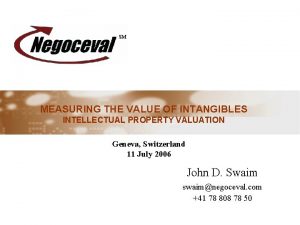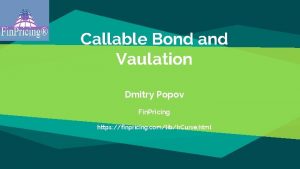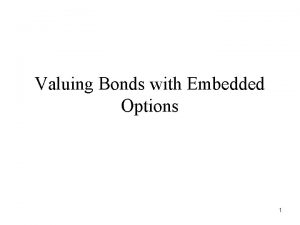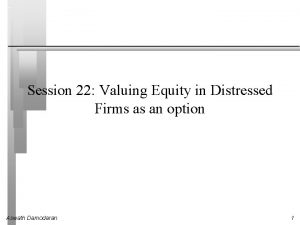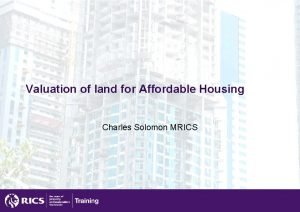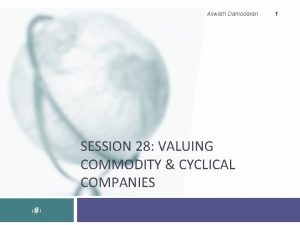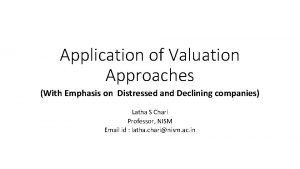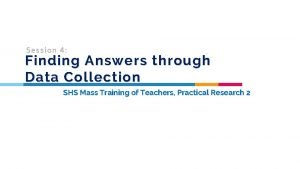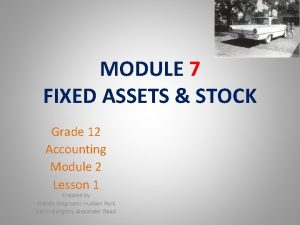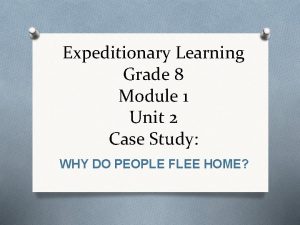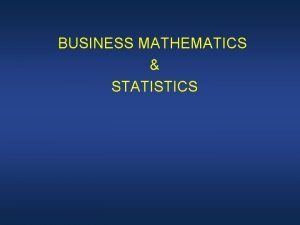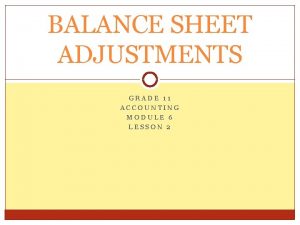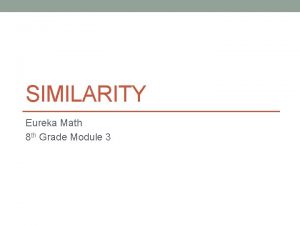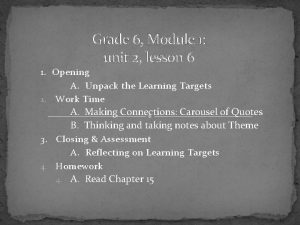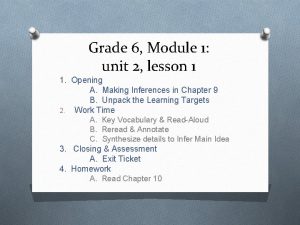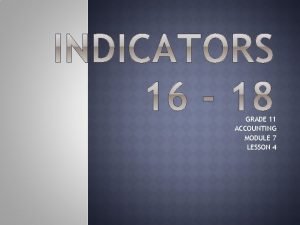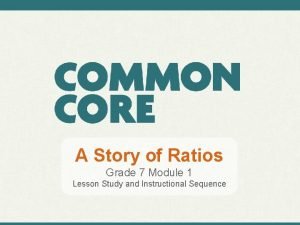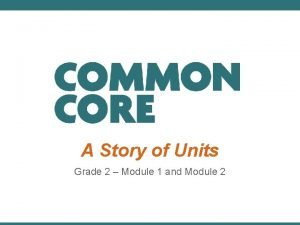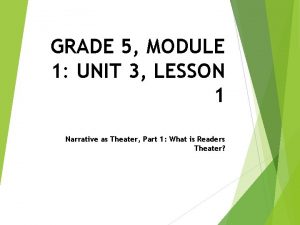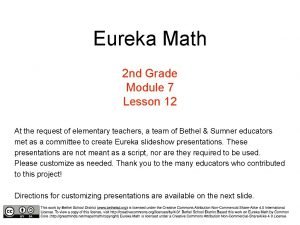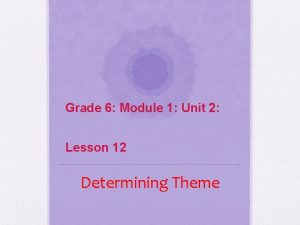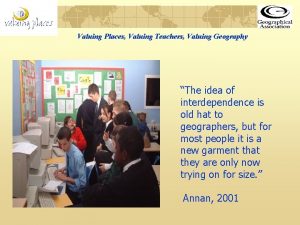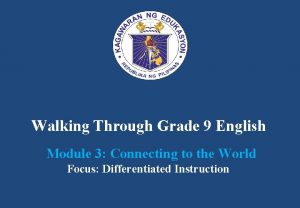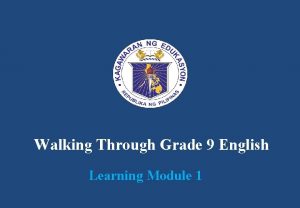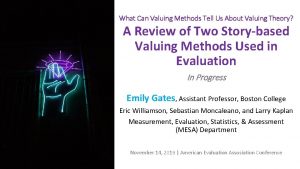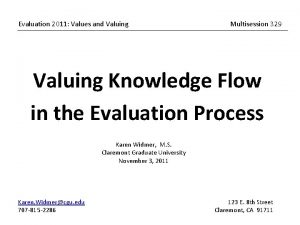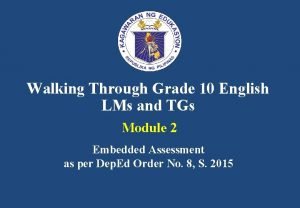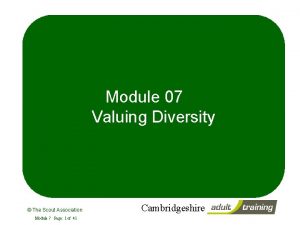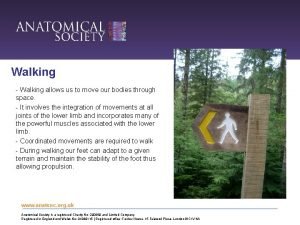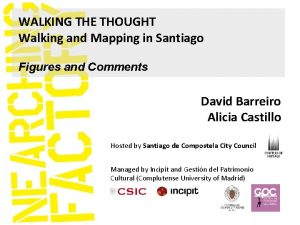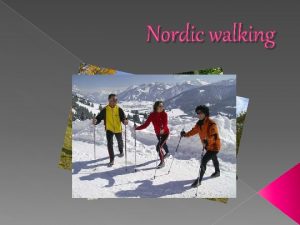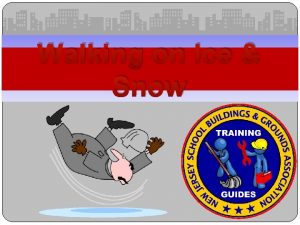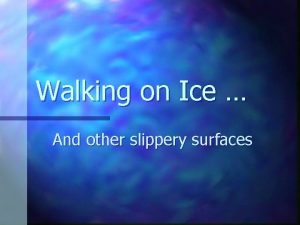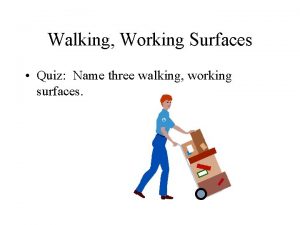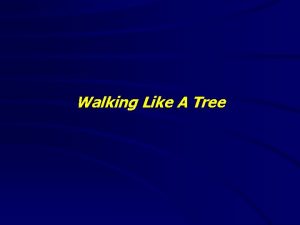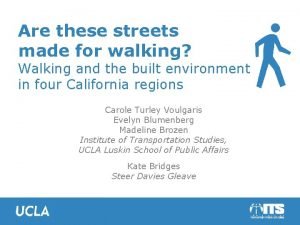Walking Through Grade 9 English Module 2 Valuing





































- Slides: 37

Walking Through Grade 9 English Module 2: Valuing Others and Their Circumstances Focus: Embedded Assessment

GETTING READY! • Visit Module 2 of the Learner’s Material (LM) • Read all the tasks under each phase (Your Initial task, etc) • Classify the tasks in the assigned lesson as to the levels of assessment (KPUP) • Identify the part of holistic assessment used in the task (check one in the list) DEPARTMENT OF EDUCATION

GETTING READY! • Use the template below for the said purpose LESSON No. ___ and Task Title Task No. Levels of Assessment (KPUP) Purpose of Assessment (Check One) Pre –assessment (Diagnostic) Formative Assessment (Developmental) • Write your answers on a manila paper • Have your outputs presented to the class DEPARTMENT OF EDUCATION Summative Assessment (Evaluative)

How did you find the activity? DEPARTMENT OF EDUCATION

What have you noticed from your answers? DEPARTMENT OF EDUCATION

Why is it necessary to assess the students before, during and after the lesson? DEPARTMENT OF EDUCATION

How did you feel when you’re classifying the embedded assessments in the tasks by level? DEPARTMENT OF EDUCATION

What helped you in classifying them? DEPARTMENT OF EDUCATION

What have you realized about assessment of learning outcome? DEPARTMENT OF EDUCATION

Holistic Assessment GUIDING PRINCIPLE: Prior Learning as Process PREASSESSMENT (Diagnostic) FORMATIVE ASSESSMENT (Developmental) SUMMATIVE ASSESSMENT (Evaluative) “Your initial task”(LM) (Embedded) “Your Text” “Your Discovery Task” (Embedded) “Final Task” (LM) “Pretest” (TG) Learning as Outcome “Post Test” (TG)

Holistic Assessment § Standard-Based • Assess for Attainment of Content Standard Level 1 – Knowledge Level 2 – Process/Skills Level 3 – Understanding • Assess for Attainment of Performance Standard Level 4 – Products/Performances

Knowledge Assessment KNOWLEDGE – Recalling data or information, making sense of ideas, translating, interpolating and interpreting problems and instructions Key words: • Define, describe, identify, know, label, list, match, name, outline, recall, recognize, reproduce, select, state • Comprehend, defend, distinguish, estimate, explain, extend, generalize, give examples, infer, interpret, paraphrase, predict, rewrite, summarize, translate • Analyze, breakdown, compare, contrast, diagram, deconstruct, differentiate, discriminate, distinguish, identify, relate, select, separate

Knowledge Assessment Example: Lesson 7 (Your Text) Page 223 Task 5 is a under KNOWLEDGE because it requires students to “recall “ information from the text.

Process Assessment PROCESS - skills or cognitive operations that the student performs on facts and information or the purpose of constructing meanings and understanding. Key words: • Illustrate, outline, apply, change, compute, construct, demonstrate, discover, manipulate, modify, operate, predict, prepare, produce, relate, show, solve, use.

Process Assessment Example: Lesson 7 (Your Text) Page 231 Task 14 is a under PROCESS because it requires students to perform cognitive operations on facts and information in the form of “application” and/ or “establishing relationships”

Assessment at the Level of Understanding UNDERSTANDING – Enduring big ideas, principles and generalizations inherent to the discipline, which may be assessed using the facets of understanding or other indicators of understanding which may be specific to the discipline Key words: • Appraise, conclude, criticize, critique, defend, evaluate, explain, justify, relate, summarize, support

Assessment at the Level of Understanding Example: Lesson 7 Page 234 My Treasure is under UNDERSTANDING because it requires students to see the big or enduring ideas.

Performance Assessment PRODUCT/PERFORMANCE - real-life application of understanding as evidence d by the student’s performance of authentic tasks. Key words: • Compile, compose, create, devise, design, generate, modify, organize, plan, rearrange, reconstruct, reorganize, revise, rewrite, summarize, write • apply, change, compute, construct, demonstrate, discover, manipulate, modify, operate, predict, prepare, produce, relate, show, solve, use

Performance Assessment Example: Lesson 7 Page 232 Task 16 is under PERFORMANCE because it requires students to perform an developmental /enabling / culminating activity. .

Holistic Assessment PRE-ASSESSMENT (Diagnostic: Prior Learning)

Pre-Assessment Answers the questions: 1. What pre-requisite knowledge, skills and/or understanding do I need information on that, as teacher, I can build on to teach new knowledge and develop new skills and understandings that will enable my students to produce the expected product or performance? 2. What tools will be appropriate to collect information? 3. How will I use the results of the pre-assessment? Knowledge Skills/Process Understanding Product/ Performance

Move on to th e new lesson Day 1 Day 5 Enrich/ Move on Pre-Assess Teach Check for Learning Enrich/Move on Remediate Day 2 Assess Learning Grade Remediate Day 4 Teach Check for Learning Remediate Teach Check for Learning Day 3 Teach Check for Learning Enrich/ Move on

Pre-Assessment Example: Lesson 7 (Page 217 of LM) Task 1: BUNDLE OF JOY What can a bundle do? Write your thoughts about the photos below and explain why it is better if they come in bundle/group. < broom stick> < society of ants> < battalion of soldier> < pages of a book> < school of fish> Task 1 is a type of pre-assessment because it is diagnostic in nature. It attempts to guage student’s prior knowledge or schema on “working with others”

Think about this: Should pre-assessment be made basis for grading? NO! Pre-assessment is used to collect data as to where the teacher should start delivering the lesson. It is not a means to measure student’s “true achievement” that makes pre-assessment an “Assessment for Learning”

Holistic Assessment FORMATIVE ASSESSMENT (Developmental: Assessment of Learning as Process)

Formative Assessment Answers the Questions: 1. How will I and my students to track their learning progress in relation to what they need to: a. know? b. be able to do? And c. understand? so that on their own, they will be able to produce the expected product or performance. 2. What teacher and student tools will be appropriate to collect such information? 3. How will I and my students utilize the results of the assessment?

Move on to th e new lesson Day 1 Day 5 Enrich/ Move on Pre-Assess Teach Check for Learning Enrich/Move on Remediate Day 2 Assess Learning Grade Remediate Day 4 Teach Check for Learning Remediate Teach Check for Learning Day 3 Teach Check for Learning Enrich/ Move on

Formative Assessment Example: Lesson 7 (Your Text) (Page 225 of LM) Task 7 is a type of FORMATIVE assessment because it is developmental in nature. It attempts to assess learning as a “process”

Think about this: Should formative assessment be made basis for grading the students ? NO! Formative assessments is used to collect data to improve teaching or improve strategies. That makes formative assessment an “Assessment for Learning”. It also helps students track their own progress that makes it “Assessment as Learning”

Holistic Assessment SUMMATIVE ASSESSMENT (Evaluative: Assessment of Learning as Outcome)

Summative Assessment Answers the questions: 1. How do I evaluate what has been learned in terms of: • knowledge (what students know) • process/skills (what students can do with what they know; how they make sense of the knowledge and information) • understanding (what meanings children have constructed or made); and • products and performances (how children use or transfer their understanding or learning to real-life situations) -

Summative Assessment 2. What criteria I will use? 3. What tools will be appropriate to evaluate products and performances? 4. How will I utilize the results of the evaluation?

Move on to th e new lesson Day 1 Day 5 Enrich/ Move on Pre-Assess Teach Check for Learning Enrich/Move on Remediate Day 2 Assess Learning Grade Remediate Day 4 Teach Check for Learning Remediate Teach Check for Learning Day 3 Teach Check for Learning Enrich/ Move on

Summative Assessment Example: Lesson 7 (Your Text) (Page 232 of LM) Task 16 is a type of SUMMATIVE assessment because it the culminating activity from which the students TRUE ACHIEVEMENT shall be assessed/evaluated.

Think about this: Should summative assessment be made basis for grading the students ? YES! Summative assessments are used to EVALUATE students’ true achievement. That makes summative assessment an “Assessment of Learning”.

Revisit, Reflect and Revise • Go back to your outputs in the preliminary activity • Check whether your initial answers are correct • Make revisions if necessary

Walking Through Grade 9 English “If you don’t know where you are headed, you’ll probably end up someplace else. ” -Douglas J. Eder, Ph. D. - DEPARTMENT OF EDUCATION
 Wading through treacle
Wading through treacle Achieving through english module
Achieving through english module Grade 9 english unchanging values in a changing world
Grade 9 english unchanging values in a changing world Example of contextualization and localization
Example of contextualization and localization English module grade 10 unit 3
English module grade 10 unit 3 Valuing a private company
Valuing a private company Psychomotor domain objectives examples in lesson plan
Psychomotor domain objectives examples in lesson plan Psychomotor objectives examples
Psychomotor objectives examples Domain behavior
Domain behavior Pericles describes athenian society as valuing
Pericles describes athenian society as valuing Oral language quotes
Oral language quotes Valuing innovation
Valuing innovation Valuation of ip
Valuation of ip Descriptive ethics vs normative ethics
Descriptive ethics vs normative ethics Callable bonds definition
Callable bonds definition Bonds with embedded options
Bonds with embedded options Valuing distressed companies
Valuing distressed companies Valuing culture
Valuing culture Valuing land for social housing
Valuing land for social housing Valuing commodity companies
Valuing commodity companies Valuing distressed and declining companies
Valuing distressed and declining companies C device module module 1
C device module module 1 Finding answers through data collection
Finding answers through data collection Principles of marketing
Principles of marketing Fixed assets accounting grade 12
Fixed assets accounting grade 12 Grade 8 module 1
Grade 8 module 1 Proportion in business math
Proportion in business math Grade 11 accounting module 1
Grade 11 accounting module 1 Grade 8 module 3
Grade 8 module 3 Eureka math grade 6 module 1 lesson 6 answer key
Eureka math grade 6 module 1 lesson 6 answer key Grade 6 module
Grade 6 module Grade 11 accounting module 1
Grade 11 accounting module 1 A story of ratios
A story of ratios Grade 2 module 1
Grade 2 module 1 Grade 5 module 1 lesson 1
Grade 5 module 1 lesson 1 Eureka math 3rd grade module 7
Eureka math 3rd grade module 7 Reading and writing grade 11 module 6
Reading and writing grade 11 module 6 Grade 6 module 1: unit 2 answer key
Grade 6 module 1: unit 2 answer key
